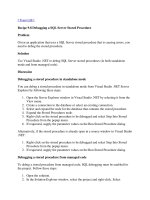Using a SqlConnection Object to Connect to a SQL Server Database phần 1
Bạn đang xem bản rút gọn của tài liệu. Xem và tải ngay bản đầy đủ của tài liệu tại đây (22.37 KB, 7 trang )
Using a SqlConnection Object to Connect to a SQL Server Database
You create a SqlConnection object using the SqlConnection() constructor. This
constructor is overloaded, meaning that there are multiple versions of the constructor that
you can call. The SqlConnection() constructors are as follows:
SqlConnection()
SqlConnection(string connectionString)
where connectionString contains the details for the database connection. You'll learn the
details of the connectionString in this section.
Assuming you've imported the System.Data.SqlClient namespace, you can create a new
SqlConnection object using the following statement:
SqlConnection mySqlConnection = new SqlConnection();
You can then set the details for the database connection using the ConnectionString
property of mySqlConnection. For example:
mySqlConnection.ConnectionString =
"server=localhost;database=Northwind;uid=sa;pwd=sa";
where
server specifies the name of the computer on which SQL Server is running.
database specifies the name of the database.
uid specifies the name of the database user.
pwd specifies the password for the user.
Warning For security reasons, do not include the username password in your production
code. Instead ask the user to enter their name and password-or use integrated
security, which you'll learn about shortly.
One thing you need to bear in mind is that you can set the ConnectionString property
only when your Connection object is closed.
You can also pass a connection string directly to the SqlConnection() constructor. For
example:
string connectionString =
"server=localhost;database=Northwind;uid=sa;pwd=sa";
SqlConnection mySqlConnection =
new SqlConnection(connectionString);
Or more simply:
SqlConnection mySqlConnection =
new SqlConnection(
"server=localhost;database=Northwind;uid=sa;pwd=sa"
);
You can set an optional connection timeout, which specifies the number of seconds that
the Open() method will wait for a connection to the database. You do this by specifying a
connection timeout in your connection string. For example, the following string specifies
a connection timeout of 10 seconds:
string connectionString =
"server=localhost;database=Northwind;uid=sa;pwd=sa;" +
"connection timeout=10";
Note The default connection timeout is 15 seconds. A connection timeout of 0 seconds
means the connection attempt will wait indefinitely. Avoid setting your connection
timeout to 0.
Before starting a Windows session, you typically log in to Windows with a username and
password. If you're using Windows integrated security, you can pass your username and
password to SQL Server and use those credentials to connect to the database. This saves
you from providing a separate username and password to SQL Server. You can use
integrated security in your program by specifying integrated security=SSPI in your
connection string. For example:
string connectionString =
"server=localhost;database=Northwind;integrated security=SSPI";
Notice that you don't provide the username and password. Instead, the username and
password you used when logging into Windows is passed to SQL Server. SQL Server
will then check its list of users to see if you have permission to access the database. (For
further details on integrated security, consult the SQL Server Books Online
documentation.)
You've now seen how to create a Connection object using program statements. You'll see
how to create a Connection object visually using Visual Studio .NET later in the
"Creating a Connection Object using Visual Studio .NET" section. Next, you'll see how
to open and close a connection.
Opening and Closing a Database Connection
Once you've created your Connection object and set its ConnectionString property to the
appropriate details for your database connection, you can open the connection to the
database. You do this by calling the Open() method of your Connection object. The
following example calls the Open() method of mySqlConnection:
mySqlConnection.Open();
Once you've finished with your database connection, you call the Close() method of your
Connection object. For example:
mySqlConnection.Close();
Listing 7.1
illustrates how to connect to the SQL Server Northwind database using a
SqlConnection object and display some of the properties of that object.
Listing 7.1: MYSQLCONNECTION.CS
/*
MySqlConnection.cs illustrates how to use a
SqlConnection object to connect to a SQL Server database
*/
using System;
using System.Data;
using System.Data.SqlClient;
class MySqlConnection
{
public static void Main()
{
// formulate a string containing the details of the
// database connection
string connectionString =
"server=localhost;database=Northwind;uid=sa;pwd=sa";
// create a SqlConnection object to connect to the
// database, passing the connection string to the constructor
SqlConnection mySqlConnection =
new SqlConnection(connectionString);
// open the database connection using the
// Open() method of the SqlConnection object
mySqlConnection.Open();
// display the properties of the SqlConnection object
Console.WriteLine("mySqlConnection.ConnectionString = "+
mySqlConnection.ConnectionString);
Console.WriteLine("mySqlConnection.ConnectionTimeout = "+
mySqlConnection.ConnectionTimeout);
Console.WriteLine("mySqlConnection.Database = "+
mySqlConnection.Database);
Console.WriteLine("mySqlConnection.DataSource = "+
mySqlConnection.DataSource);
Console.WriteLine("mySqlConnection.PacketSize = "+
mySqlConnection.PacketSize);
Console.WriteLine("mySqlConnection.ServerVersion = "+
mySqlConnection.ServerVersion);
Console.WriteLine("mySqlConnection.State = "+
mySqlConnection.State);
Console.WriteLine("mySqlConnection.WorkstationId = "+
mySqlConnection.WorkstationId);
// close the database connection using the Close() method
// of the SqlConnection object
mySqlConnection.Close();
}
}
The output from this program is as follows:
mySqlConnection.ConnectionString = server=localhost;database=Northwind;uid=sa;
mySqlConnection.ConnectionTimeout = 15
mySqlConnection.Database = Northwind
mySqlConnection.DataSource = localhost
mySqlConnection.PacketSize = 8192
mySqlConnection.ServerVersion = 08.00.0194
mySqlConnection.State = Open
mySqlConnection.WorkstationId = JMPRICE-DT1
Note Your results will differ from those here. For example, your connection string and
workstation ID will be different.
Connection Pooling
Opening and closing a database connection is a relatively time-consuming process. For
this reason, ADO.NET automatically stores database connections in a pool. Connection
pooling offers a great performance improvement because you don't have to wait for a
brand new connection to the database to be established when there's a suitable connection
already available. When you close a connection, that connection isn't actually closed;
instead, your connection is marked as unused and stored in the pool, ready to be used
again.
If you then supply the same details in the connection string (same database, username,
password, and so on), then the connection from the pool is retrieved and returned to you.
You then use that same connection to access the database.
When using a SqlConnection object, you can indicate the maximum number of
connections allowed in the pool by specifying max pool size in your connection string
(the default is 100). You can also indicate the minimum number of connections in the
pool by specifying min pool size (the default is 0). For example, the following
SqlConnection specifies a max pool size of 10 and a min pool size of 5:
SqlConnection mySqlConnection =
new SqlConnection(
"server=localhost;database=Northwind;uid=sa;pwd=sa;" +
"max pool size=10;min pool size=5"
);
In this example, a pool with five initial SqlConnection objects is created. A maximum of
10 SqlConnection objects can be stored in the pool. If you attempt to open a new
SqlConnection object and the pool is already full with currently used objects, your
request waits until a SqlConnection object is closed, at which point that object is returned
for you to use. If your request waits longer than the number of seconds in the
ConnectionTimout property, then an exception is thrown.
Listing 7.2
illustrates the time-saving when opening a previously pooled connection.
Listing 7.2: CONNECTIONPOOLING.CS
/*
ConnectionPooling.cs illustrates connection pooling
*/









